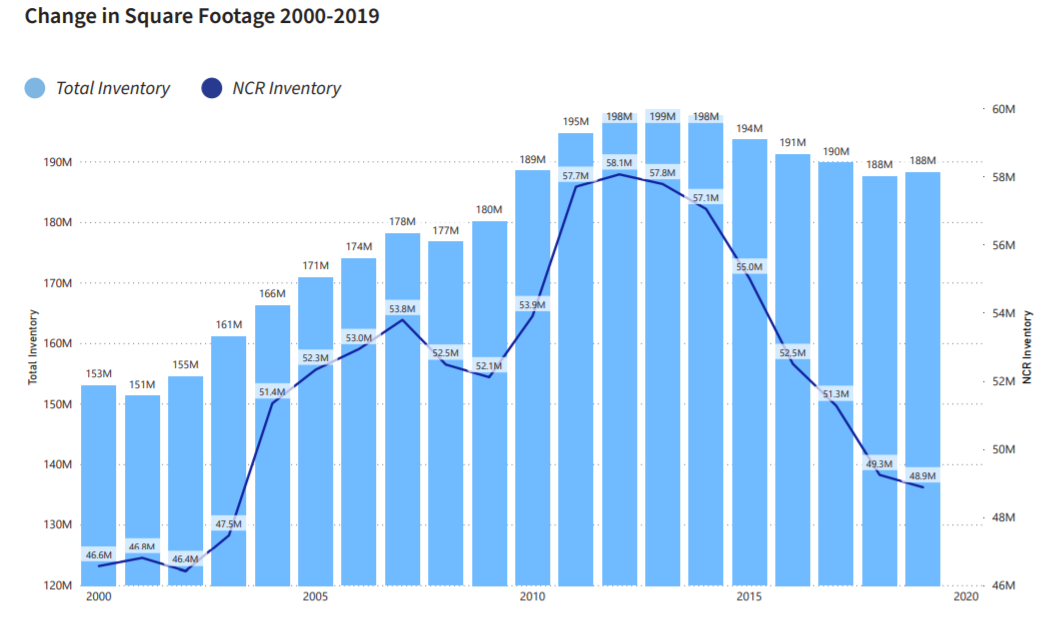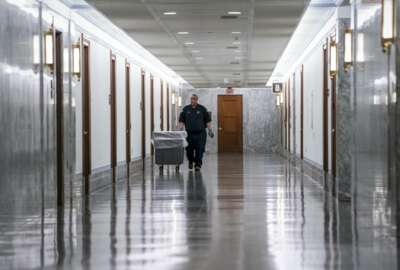
GSA’s federal buildings office, running virtually, sets stage for agencies reopening
GSA's Public Buildings Service has responded to the emerging needs of tenant agencies, and has taken steps to prepare for a gradual influx of employees at the...
Best listening experience is on Chrome, Firefox or Safari. Subscribe to Federal Drive’s daily audio interviews on Apple Podcasts or PodcastOne.
Roughly two months into the coronavirus pandemic, as governors take the first steps in a phased approach to reopen their states, the White House has directed federal agency heads to bring more employees back to the office based in part on those state decisions.
Throughout the pandemic, however, the General Services Administration’s Public Buildings Service has responded to the emerging needs of tenant agencies and has taken steps to prepare for a gradual influx of employees at the federal buildings it manages.
Requests include disinfecting sites where federal employees have tested positive for the coronavirus, and working with the Federal Emergency Management Agency, the Army Corps of Engineers and Army Medical Command to set up an emergency hospital site at CenturyLink Field in Seattle, Washington.
Some of those emergency sites, including the CenturyLink Field hospital, have closed without treating any patients. But PBS Commissioner Dan Mathews told Federal News Network that the agency in some cases has had to acquire more space than its partners expect they will need.
“If you’re an agency that has an operation center that’s fully up and running because you’re responding to this coronavirus disaster, you want to make sure that you’re having some social distancing in your operation center. And you also want to be able to stagger your workforce, so that if you do have somebody infected in your operation center, you don’t contaminate the whole team, and you can also continue to operate,” Mathews said.
IT ‘investment’ paying off for PBS
Meanwhile, federal agency heads are now looking at ways to strike a careful balance between bringing more employees back into the office and avoiding a spike in coronavirus cases.
Guidance from the Office of Management and Budget and the Office of Personnel Management last month sets out a phased reopening for the federal government, which allows GSA to follow much of the same playbook it’s used already for emergency response.
Mathews said the guidance creates an opportunity for PBS to break its workforce into teams and send them back to the office for weekly rotations.
“You can stagger them throughout the facility so that Team Two is not sitting in the same space as that Team One was in. And if somebody is infected in Team One and you have to quarantine Team One, well by the time that week is over, when they would rotate back into the facility, that quarantine period would have passed, and they would have never cross-contaminate any of the other teams,” he said.
The guidance from OMB and OPM also stresses the continued use of telework in the first two phases of reopening. Reducing the density of employees in a workspace allows workers in that office to continue social distancing, if implemented properly.
The transition into reopening may be the easiest for GSA, which is already the biggest adopter of telework in the federal government.
“The investment in the IT has really made a world of difference for GSA,” Mathews said. “Agencies that have made similar investments are in a much stronger position to perform their mission under the current situation than agencies who either haven’t made that investment or might not have the ability,” such as agencies with a large classified information workload.
GSA has also digitized many of the paper-based processes that have forced other agencies to recall employees sooner.
The IRS, for example, asked about 11,000 of its staff last month to volunteer to return work in 10 facilities to handle essential mission-critical work for the tax filing season, which now ends on July 15. That work includes answering phones, processing mail and other essential work they can’t complete while teleworking.
Virtual tours, e-signed leases for continuity of operations
But PBS has taken the extra step of conducting virtual tours of facilities that might otherwise involve a group of 10 more people before the agency signs an agreement with contractors.
“We’ve been really quite innovative and adaptive in terms of using technology, where in the past, we may have brought 10 people onto a site, now we might bring one GSA employee on-site, a building inspector and a construction representative,” Mathews said. “They can socially distance and they’ll use technology to basically have a visual walkthrough, so that the rest of the inspection team can do their work off-site remotely, and basically direct the camera to go see what they need to see.”
With one-in-four federal leases expiring between 2019 and 2021, the PBS continues to replace expired leases with long-term solutions, as per an agency-wide goal. GSA has been a leader in adopting electronic signatures, and PBS has taken this a step further with an electronic lease platform that has allowed PBS to completely sign and accept facility leases.
On any given year, PBS has nearly $7 billion in construction projects underway, and despite a few work stoppages because of the pandemic, Mathews said the vast majority of those projects have continued.
In some cases where federal buildings are unoccupied, he added that work on some projects have accelerated. Construction companies have put requirements in place for social distancing and have provided personal protective equipment for employees.
Meanwhile, PBS continues to onboard employees in a “completely virtual fashion,” aside from some instances where new employees may need to pick up a physical credential to log-in remotely.
“Other than that, equipment gets mailed out to them, everything is done online until we’re able to get our workforce steady and moving forward, notwithstanding the situation we’re in,” Mathews said. “That’s been good for the economy – the last thing we want to do is stop $7 billion worth of construction in this environment. That would not be a good place for our tenants, for the taxpayer or for the economy.”
Managing open offices while social distancing
Meanwhile, the decision to reopen some agency facilities comes with the added challenge of a governmentwide consolidation of office space and agencies moving to open-office designs.
Over the course of his tenure at the Public Buildings Service, former commissioner Norman Dong oversaw a multi-administration mandate to consolidate the federal real estate footprint.

Agencies have driven down the governmentwide footprint in recent years and saved money on rent and maintenance costs.
But Dong, now managing director of the real estate firm FD Stonewater, said the trend toward fitting more federal employees into an office space and building open-designs may pose a challenge as agencies look to reopen.
“It’ll be interesting to see, as you move to much more of an open office space concept, what the perspective will be on that issue going forward — where you’ve got many employees sitting in benching-type arrangements, where they are several feet apart from one another,” Dong said in an interview.
As the IRS recalls employees, the agency has required them to wear masks while working in proximity to others, if they don’t have a private office or a walled cubicle. Employees must also wear a mask when entering or leaving the building.
The National Treasury Employees Union said an IRS employee in Kansas City recently tested positive for the coronavirus, but PMA President Hooper said the agency has been on top of sanitizing spaces quickly to continue operating.
“The IRS has been very diligent about immediately shutting down those workspaces and cordoning them off, bringing in a cleaning service to disinfect everything before we clear it to reopen again,” Hooper said.
Employees in some cases have had to resume work at a space that wasn’t originally their own, and have had to sit in the seats of colleagues who continue to telework.
Read more Facilities/Construction news
“We do have concerns there that have bubbled up, like how well those desks and chairs can be cleaned, given it’s a shared workstation, to some respect, and who should be doing that cleaning. Should the employee be wiping down their desk? Should the manager? Should a contractor? Those sorts of things crop up,” Hooper said, adding that PMA does not feel as though federal employees should be responsible sanitizing their own workstation, citing safety concerns.
Meanwhile, IRS has also posted signs throughout its buildings to explain the mask requirements.
“There’s also signage about symptoms to look out for, for yourself and your family. And if you’re exhibiting the symptoms, or someone at home is, you need to let us know immediately so that we can send you back home and ensure that the workplace is kept safe,” Hooper said.
Deep cleaning federal buildings
As for the $275 million GSA received in the CARES Act to deep-clean agency facilities, Mathews said that the agency’s cleaning contracts have a “pandemic clause” that outlines the level of treatment these facilities will undergo.
“Our contractors that provide the cleaning, they have some additional training that they have to do to ensure that their workforce is doing the work — understands the protocols of how to keep themselves safe, what type of materials they need to use for cleaning,” he said.
PBS has also worked with the Centers for Disease Control and Prevention to develop a contract vehicle for agencies seeking enhanced screening for employees, contractors and the public.
Mathews said PBS has worked with the CDC to put the final touches on guidance for tenant agencies to access this contract vehicle and to understand how best to field temperature checks or medical questionnaires.
“On a case-by-case basis, GSA would need to work with the building tenants to actually figure out, given the layout of the facility, where could that take place. Can it take place in the lobby, can take place outside the front door? A lot of that’s going to be site-specific,” Mathews said.
Copyright © 2024 Federal News Network. All rights reserved. This website is not intended for users located within the European Economic Area.
Jory Heckman is a reporter at Federal News Network covering U.S. Postal Service, IRS, big data and technology issues.
Follow @jheckmanWFED






